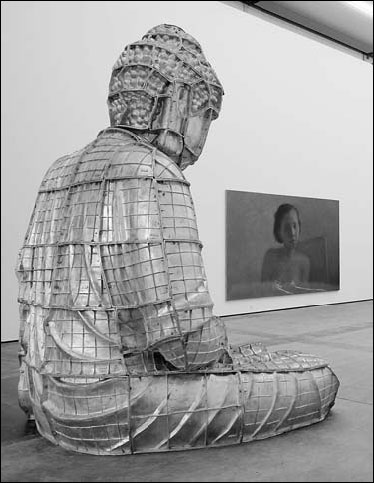Chinese art maintains distinctive presence in the Asian art market
Updated: 2013-01-29 07:26
By Nicole Kwan (China Daily)
|
||||||||
Chinese artists formed the second largest contingent after Singapore in this year's just-ended Art Stage Singapore, one of the leading contemporary art fairs in the Asia-Pacific region.
Representing Shanghai were the Purple Roof Art Gallery and ShanghART Gallery, and Aye Gallery and Triumph Art Space from Beijing.
The galleries presented a comprehensive tapestry of Asian works of art, with prominent artworks by established contemporary artists such as Zhang Huan, Mu Boyan, Zhou Tiehai, and young budding artists like Shi Jing.
"There is really nothing like Chinese art," shares Amos Aldren, an avid Chinese art collector from Melbourne, Australia. "Take for example, Zhang Huan's work, which features philosophical ideas of yin and yang in Berlin Buddha. Nothing typifies Asian more strongly than that."
China remains an important factor in the international contemporary art market today with a distinctive presence in the Asian art market, which, according to art fair director, Lorenzo Rudolf, "has proven itself to be a mainstay and has forged global tastes."
The Chinese galleries displayed various contemporary art forms at this year's event.
A tongue-in-cheek piece by Lee Kit shows a hand-painted tablecloth. An installation by Mu Boyan of a rotund character scaling a tall stepladder depicts how society's individuals are "fat with resources but are never satisfied".
The philosophical works of one cutting-edge artist, Shi Jing, exhibit acrylic paintings that are solely in black and white and illuminated using different colored lighting. It presents the different facades of what initially seem like a two-dimensional picture.
The annual event, which is in its third year, was held between Jan 24 and 27.
It took up not one, but three international convention halls at the iconic Marina Bay Sands, with every wall filled with art pieces - offerings proudly presented by a kaleidoscope of internationally acclaimed galleries and artists.
On its first day, the fair opened its doors to some 7,000 art aficionados from all over the world. Visitors to the fair were greeted by The Floating Skeleton, the first of many installation pieces at this year's event by the entrance.
Contributed by fairground design architect WY-TO, the massive web-like structure resembles a bridge made up of interwoven metal and cloth.
The exhibit was symbolic of the art fair's purpose, which was to establish a strong Asian art identity by creating a network of ties between diverse artists across the region and beyond, with Singapore bridging the gap between regional and international artists, galleries and collectors.
With its strong ties to both East and West, Singapore is both a financial and cultural gateway into Southeast Asia, making it an ideal location for the hosting of this massive fair, which aims to promote Asia's artistic creativity.
Rudolf, the veteran art fair director, who headed prominent art fairs Art Basel and ShContemporary, says that art fairs are not only a place where multicultural exchanges take place, but also have a responsibility to protect art's identity.
"We do not want to have Chinese artists only represented by Western galleries, hence we need to create an environment where Asian artists and Asian galleries are also well-represented," Rudolf says.
The fair also hosted other international heavyweights including White Cube (London), Halcyon Gallery (London/Shanghai), and Zemack Contemporary Art (Tel Aviv).
This year's fair focused on Southeast Asian art, in particular Indonesian art, which is seeing rising interest.
Dedicated to promoting visibility and accessibility for both fledgling artists who do not possess the means to compete with their Western counterparts, the organizers introduce special platforms such as the Indonesian Pavilion.
The pavilion showcased outstanding Indonesian galleries as well as a curated collection of Indonesia's leading contemporary artists. It also included an education center managed by the Indonesian Visual Art Archive.
Rudolf explains that China did not have its own pavilion at this year's fair because "China has a very strong arts infrastructure that has launched their artists and galleries internationally already."
By juxtaposing Asian and Western gallery booths, and incorporating guided tours and talks at this year's fair, Rudolf envisions more artistic exchange and conversations about art, furthering the ideals of Asian art among art experts and enthusiasts, as well as preserving and promoting the Asian art identity.
China Daily
|
The 2013 Art Stage Singapore features Chinese artist Zhang Huan's Berlin Buddha. Provided to China Daily |
(China Daily 01/29/2013 page20)

 In Photos: 7.0-magnitude quake hits Sichuan
In Photos: 7.0-magnitude quake hits Sichuan
 Li Na on Time cover, makes influential 100 list
Li Na on Time cover, makes influential 100 list
 FBI releases photos of 2 Boston bombings suspects
FBI releases photos of 2 Boston bombings suspects
 World's wackiest hairstyles
World's wackiest hairstyles
 Sandstorms strike Northwest China
Sandstorms strike Northwest China
 Never-seen photos of Madonna on display
Never-seen photos of Madonna on display
 H7N9 outbreak linked to waterfowl migration
H7N9 outbreak linked to waterfowl migration
 Dozens feared dead in Texas plant blast
Dozens feared dead in Texas plant blast
Most Viewed
Editor's Picks

|

|

|

|

|

|
Today's Top News
Live report: 7.0-magnitude quake hits Sichuan, heavy casualties feared
Boston suspect cornered on boat
Cross-talk artist helps to spread the word
'Green' awareness levels drop in Beijing
Palace Museum spruces up
First couple on Time's list of most influential
H7N9 flu transmission studied
Trading channels 'need to broaden'
US Weekly

|

|








